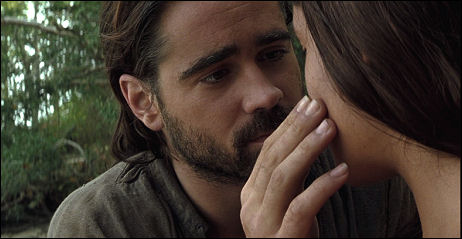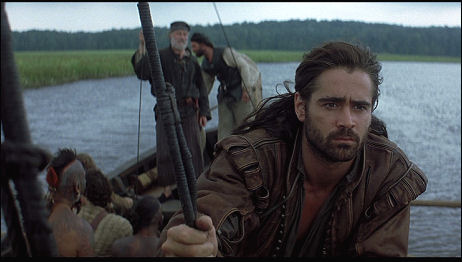I never felt that the story told by Terrence Malick‘s The New World really worked, particularly the last third, but I’ve always been in love with the primeval splendor of the thing. As I tried to explain in my initial review: “[During] those first two thirds, The New World is a truly rare animal and movie like no other…a feast of intuitive wow-level naturalism that feels as fresh and vitally alive as newly-sprouted flora.”

Which is why I intend to purchase the forthcoming New World “Extended Cut” Blu-ray. For those first two thirds, I mean. It runs 172 minutes (despite the Amazon page stating otherwise) or 22 minutes longer than the 150-minute version that had a brief theatrical run in late ’05 before New Line Cinema honchos freaked and leaned on Malick to trim it back to 135 minutes for a somewhat wider release that began, as I recall, in late January.
I have this feeling that more and more people are coming around to this point of view. That despite the disappointing last-third turn The New World is one of the greatest dive-in-and-live-in-the-realm movies of all time. A movie clearly uninterested for the most part in telling a gripping story but one that atmospherically mesmerizes in such a way that it feels like somebody put mescaline in your tea.
Gary Tooze‘s DVD Beaver review of the forthcoming Blu-ray puts it nicely:
“It is so refreshing to see such poetic images that can speak luminous volumes in a modern epically proportioned film. Based on the classic Pocahontas and John Smith legend, director Terrence Malick scripted this penetrating drama of conflict between Native Americans and English settlers in the 17th century ‘New World’. The heart of each film in Malick’s sporadic oeuvre must be cinematography. This is shot in Virginia by Emmanuel Lubezki, and continually overwhelms us with beauty, wild detail and washes us clean like a breath of mountain air. With organic precision [and] the grace of your senses, ‘masterpiece’ seems an understatement.”

What was wrong with the last third? I believed in the current between Colin Farrell and whatsername who played Pocahantas, and I felt betrayed when he suddenly bailed on her and went back to England. And I resented Christian Bale stepping in and trying to take Farrell’s place. And I couldn’t have cared less about all that royal court in England stuff. Pocahantas dying young didn’t seem to mean much. It’s what happened, yes, but it’s not what I wanted to see.
Some of us don’t remember how badly The New World was ripped by several big-name critics when it first opened.
Salon‘s Stephanie Zacaharek said Malick “may not care much for people, but he never met a tree he didn’t like.” (Somebody previously said this when The Thin Red Line came out, only they used “leaf” instead of “tree.”) Zacharek called it “so much atmospheric tootle” and said Malick’s “idea of using actors in a movie is straight out of ‘Where’s Waldo?'”
The L.A. Weekly‘s Scott Foundas calls it “suffocating…a movie less interested in expanding the boundaries of narrative cinema than in forsaking them.”
The hands-down funniest blurb was from Mike Clark’s USA Today review: “That sound you’re about to hear is the cracking of spines as Terrence Malick enthusiasts like me bend over backward trying to cut The New World a break.”

Second prize went to e-Film Critic’s Eric Childress: “Between the Smith-wanna-poke-a-hontas relationship, the seditious behavior back in Jamestown and the fear of the naturals that their kindness may be turned against them, a story as vast of The New World should serve as more than just a footnote in American history and a stain on the art of storytelling for all eternity.”
I wonder if any of these critics or anyone who dismissed The New World four and a half years ago have started to come around to it?
